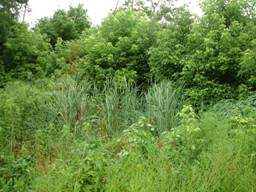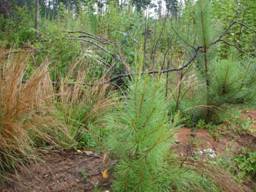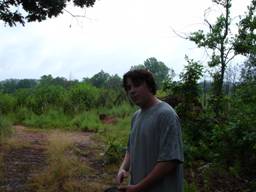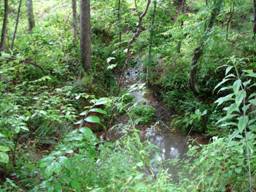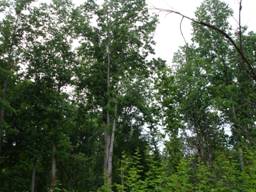This is my 2007 tree farmer of the year article from Virginia Forest Fall 2007 issue.
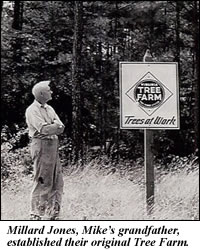
Mike T. Jones and his family were selected by the Virginia Tree Farm Committee as outstanding Tree Farmers of 2007. Mike’s Springview Farm spreads across 335 acres on a beautiful stretch of rapids in the Nottoway River at the northern edge of Greensville County, Virgnia, near the community of Purdy. The Nottoway River is a big part of Mike’s life and story. He loves the river and works hard to protect its natural beauty, clean water and abundant wildlife. Herons, eagles and osprey patrol his one and a half miles of river frontage. A variety of fish, including the endangered Roanoke Logperch, thrive in the clear flowing stream. Mike has created various wildlife infrastructure such as nesting platforms for osprey, woodduck and tree swallow boxes. He uses discarded Christmas trees for fish structure in the three ponds. His personal “Hole-In-The-Woods” project involves placing nest boxes throughout the farm that will invariably be utilized by many wildlife species (e.g. flying squirrels, gray squirrels, Great-Crested Flycatchers, owls, etc.)
Mike has constructed and maintains over three miles of fences to exclude livestock from timberland, sensitive wetlands and stream corridors (alternate livestock water sources are provided); he is conscientious when using herbicides for brush control, timber management and wildlife enhancement; his roads are properly constructed with water bars to avoid erosion; and he maintains wildlife friendly buffers around all pastures, crop fields and other open areas. Soft edges between forests and fields are the norm here.

Forestry is a family affair for Mike Jones. It was his grandfather, Millard M. Jones, who originally established the Tree Farm on portions of this land and was publicly recognized by the governor of Virginia as our state’s first Tree Farmer in 1947. Mike’s four children still work around the farm and are carrying on the family tradition. Springview Farm is the perfect example of sustainable forestry. The picture of Mike’s grandfather standing next to his Tree Farm sign, in front of a healthy stand of loblolly pine, could be reenacted today. Despite two generations of harvests, the forest of today looks similar to 1947.
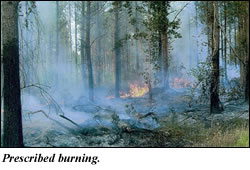
Springview Farm is outstanding proof that our land can produce wood, clean water, recreation and wildlife at the same time. However, doing this correctly requires diligence and an astute understanding of forestry and wildlife management concepts. Mike, who manages his land in harmony with natural principles, is an excellent steward of all our natural resources.Virginia’s forest evolved with fire. Native Americans used fire as a management tool to encourage game species. Preventing all fires in the forest can encourage pests, alter the fundamental nature of the forest, and create volatile conditions that can lead to disastrous situations.
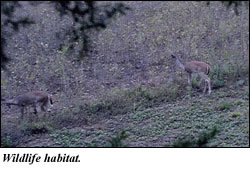
However, since fire is a natural and necessary component of our forest ecology, it is also a potential friend. Mike Jones is a certified prescribed burning manager who knows how to use fire as the environmentally friendly tool it is. He burns the pine understory and warm-season grass fields on a
regular schedule to release nutrients, significantly improve wildlife values, control understory habitat and improve growth potential. This wise use of the practice on forestland is producing a beautiful savanna pine forest similar to what likely existed in 1607.
Mike is also experimenting with longleaf pine. The longleaf was once common in southeastern Virginia, but years of development and diligent fire suppression (the longleaf ecology depends on fire) have reduced it to mere remnants. Mike’s farm is located on the northern edge of the Longleaf’s natural range and he has dedicated a site to improved longleaf pine seedlings, which are still in the “grass stage.”
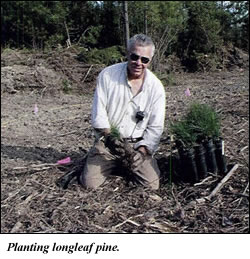
Wildlife thrives. Deer and wild turkey are common sights on Springview Farm. Although bear and bobcat are seen less often, they are often watching you. Mike ensures that necessary forestry operations leave no long-term scars. After a recent harvest, for example, he ripped the compressed soil at his log decks and planted them with forages, allowing them to quickly recover and become wildlife feeding plots. Mike also assures that the forest edge flows into the field with a soft boundary that protects wildlife and provides an additional habitat type. A beautiful riparian buffer of mature hardwood trees borders this entire one and a half mile stretch of the Nottoway River.
That old philosophical conundrum —whether a tree falling in the forest makes a sound if nobody is there to hear it—has particular meaning to forest owners. We are dealing with an increasingly urban population, remote from the rhythms of the country and the cycles of nature. They often do not understand the principles of good forestry and may be suspicious of those who utilize and harvest the products of the forest. After all, the forester’s years of good work are often literally hidden in the woods, while some of the less attractive aspects of harvests, and especially the period immediately following harvests, may attract attention.
This is where Mike Jones is performing a valuable service to every forester and the 384,000 private forest landowners in Virginia. In many ways he has opened Springview Farm to the public and this has allowed many people to learn about the stewardship aspect of forestry. He hosts the annual Virginia Tech soils tour of the state, as well as an ornithology class from Longwood University. The Boy Scouts are regular visitors to his farm. His segment of the Nottoway River is a macro-invertebrate study area used to monitor water quality. Mike leads wildflower field trips, in this respect doing double duty by showing the wildflowers themselves and defining their dependence on good forestry practices such as prescribed burning. Last fall Mike hosted the Southside Virginia Forestry and WildlifeTour. It was on a Virginia Tech Extension Southside forest tour in October 2006 that Georgia-Pacific forester Scott Detar met Mike. After a tour of his Tree Farm, Scott knew that Mike was a very special landowner doing great things on his land. It was then that Scott decided to nominate him for Outstanding Virginia Tree Farmer of the Year.
Scott was right. Mike Jones is an extraordinary landowner. He and his family have introduced hundreds of people to the beauty, bounty and diversity of a well-managed Tree Farm. Their efforts are an inspiration to all on how the many principles of natural resource management, stewardship and tree farming can be blended successfully.
VFA and the Virginia Tree Farm Committee heartily congratulate Mike and his family. They are making us all look good.

